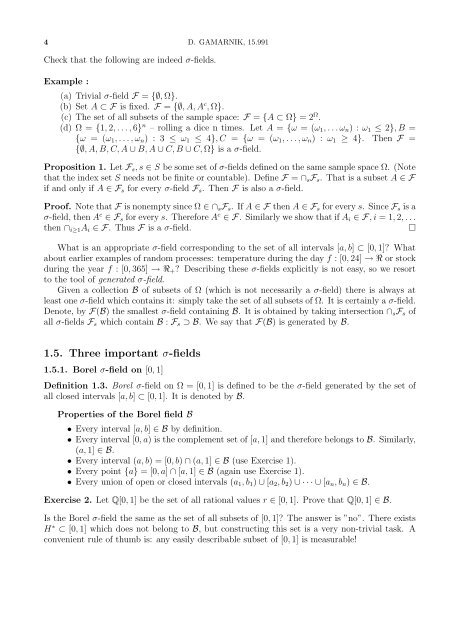Advanced Stochastic Processes.
Advanced Stochastic Processes.
Advanced Stochastic Processes.
You also want an ePaper? Increase the reach of your titles
YUMPU automatically turns print PDFs into web optimized ePapers that Google loves.
4 D. GAMARNIK, 15.991<br />
Check that the following are indeed σ-fields.<br />
Example :<br />
(a) Trivial σ-field F = {∅, Ω}.<br />
(b) Set A ⊂ F is fixed. F = {∅, A, A c , Ω}.<br />
(c) The set of all subsets of the sample space: F = {A ⊂ Ω} = 2 Ω .<br />
(d) Ω = {1, 2, . . . , 6} n – rolling a dice n times. Let A = {ω = (ω 1 , . . . ω n ) : ω 1 ≤ 2}, B =<br />
{ω = (ω 1 , . . . , ω n ) : 3 ≤ ω 1 ≤ 4}, C = {ω = (ω 1 , . . . , ω n ) : ω 1 ≥ 4}. Then F =<br />
{∅, A, B, C, A ∪ B, A ∪ C, B ∪ C, Ω} is a σ-field.<br />
Proposition 1. Let F s , s ∈ S be some set of σ-fields defined on the same sample space Ω. (Note<br />
that the index set S needs not be finite or countable). Define F = ∩ s F s . That is a subset A ∈ F<br />
if and only if A ∈ F s for every σ-field F s . Then F is also a σ-field.<br />
Proof. Note that F is nonempty since Ω ∈ ∩ s F s . If A ∈ F then A ∈ F s for every s. Since F s is a<br />
σ-field, then A c ∈ F s for every s. Therefore A c ∈ F. Similarly we show that if A i ∈ F, i = 1, 2, . . .<br />
then ∩ i≥1 A i ∈ F. Thus F is a σ-field.<br />
□<br />
What is an appropriate σ-field corresponding to the set of all intervals [a, b] ⊂ [0, 1]? What<br />
about earlier examples of random processes: temperature during the day f : [0, 24] → R or stock<br />
during the year f : [0, 365] → R + ? Describing these σ-fields explicitly is not easy, so we resort<br />
to the tool of generated σ-field.<br />
Given a collection B of subsets of Ω (which is not necessarily a σ-field) there is always at<br />
least one σ-field which contains it: simply take the set of all subsets of Ω. It is certainly a σ-field.<br />
Denote, by F(B) the smallest σ-field containing B. It is obtained by taking intersection ∩ s F s of<br />
all σ-fields F s which contain B : F s ⊃ B. We say that F(B) is generated by B.<br />
1.5. Three important σ-fields<br />
1.5.1. Borel σ-field on [0, 1]<br />
Definition 1.3. Borel σ-field on Ω = [0, 1] is defined to be the σ-field generated by the set of<br />
all closed intervals [a, b] ⊂ [0, 1]. It is denoted by B.<br />
Properties of the Borel field B<br />
• Every interval [a, b] ∈ B by definition.<br />
• Every interval [0, a) is the complement set of [a, 1] and therefore belongs to B. Similarly,<br />
(a, 1] ∈ B.<br />
• Every interval (a, b) = [0, b) ∩ (a, 1] ∈ B (use Exercise 1).<br />
• Every point {a} = [0, a] ∩ [a, 1] ∈ B (again use Exercise 1).<br />
• Every union of open or closed intervals (a 1 , b 1 ) ∪ [a 2 , b 2 ) ∪ · · · ∪ [a n , b n ) ∈ B.<br />
Exercise 2. Let Q[0, 1] be the set of all rational values r ∈ [0, 1]. Prove that Q[0, 1] ∈ B.<br />
Is the Borel σ-field the same as the set of all subsets of [0, 1]? The answer is ”no”. There exists<br />
H ∗ ⊂ [0, 1] which does not belong to B, but constructing this set is a very non-trivial task. A<br />
convenient rule of thumb is: any easily describable subset of [0, 1] is measurable!
















